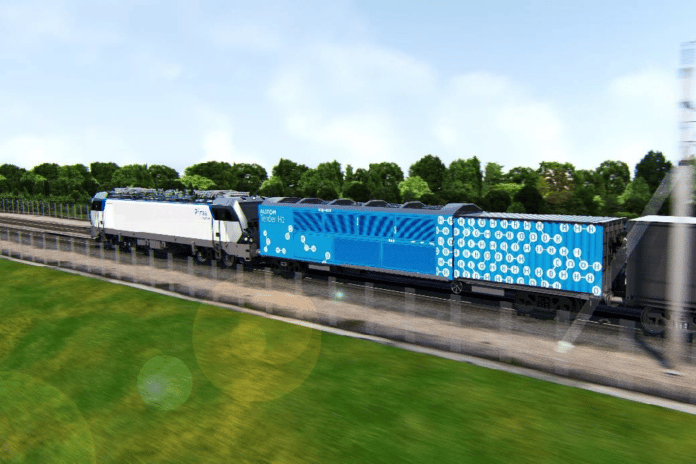In line with its supply chain decarbonisation roadmap, Nestlé Waters will be the first company in Europe to benefit from the hydrogen fuel cell solution for massified rail freight, including renewable hydrogen supply, developed by Alstom and ENGIE.
It is estimated that this project will reduce emissions by 10,000 tons of CO2 equivalent per year, in the long term – a reduction of 90% of its current emissions. This is the equivalent to the annual emissions of more than 30,000 round trips from Paris to Nice by car.
Sophie Dubois, Chief Executive Officer of Nestlé Waters in France said: “At Nestlé Waters, we favour rail freight whenever possible. We are constantly looking for efficient solutions to reduce the carbon impact of our supply chain.”
“We are very proud of this project as it represents a significant investment by our railway team to find innovative solutions to answer to climate and environmental challenge. This collaboration with Alstom and ENGIE will accelerate the development of a decarbonised/carbon-free supply chain.”
As a significant innovation, the new hydrogen solution will be developed from a high-powered fuel cell system that can power electric locomotives in non-electrified areas. This solution will be able to transport goods over long distances, on a national and European scale.
From 2025, this freight train powered by electricity from the rail network and from hydrogen in non-electrified sectors will aim to progressively ensure the transport of VITTEL® natural mineral water between the factory located in the Vosges and its various distribution centres in France (Vittel/Arles 600 kilometres and Vittel/Montreuil-Bellay 760 kilometres).
The dual-mode solution will be composed by a generator wagon incorporating a high-power fuel cell system powered by renewable hydrogen and a line-electric locomotive, all connected by an electrical power cable. The generating wagon will be able to supply the locomotive with electricity in the without the need for any catenary.
Nestlé Waters will be the first company to benefit from the hydrogen fuel cell solution for rail freight, including renewable hydrogen supply, developed by Alstom and ENGIE under a partnership announced in April 2022.
The high-power hydrogen fuel cell system developed by Alstom will power electric locomotives in non-electrified areas and offer a 100% electric solution for rail freight, end-to-end, including to the first and last kilometres, which are rarely electrified.
This innovative solution will make it possible to carry out all freight journeys with the same electric locomotive, powered by the catenary on electrified main lines and by the hydrogen generator wagon in non-electrified areas. In terms of performance, the solution will provide all the power of a catenary-based mainline electric locomotive and enough power with hydrogen energy to pull a freight train over non-electrified line segments.
ENGIE will supply the renewable hydrogen for this solution through the deployment of an innovative supply chain.
Marc Granger, Chief Strategy Officer of Alstom said: “Alstom has been a pioneer in hydrogen trains by developing the first hydrogen train in commercial operation worldwide.”
“Our ambition is to accelerate the adoption of hydrogen in the rail industry and to develop innovative solutions for the greening of mass mobility, including rail freight. Therefore, we are looking forward to the first circulation of a freight locomotive powered by renewable hydrogen in 2025. To go further, this solution, which is more environmentally friendly and generates less noise than diesel, will make it possible to develop the modal share of rail freight by offering an end-to-end electric solution, a real alternative to freight transport.”
This project with Alstom and ENGIE is the latest for Nestlé Waters, which has long favoured rail in its logistical approaches to minimize the environmental impact of transport, equivalent to a quarter of its carbon footprint4. While for French industry, the share of rail freight represents on average 58% to 10% of the volumes transported, for Nestlé Waters in France, it represents nearly 45% of the volumes of the Vosges factory.
In 2018, Nestlé Waters joined the FRET21 approach and signed an agreement with the French Agency for Ecological Transition (Agence de la Transition Ecologique – ADEME) to take action to reduce the carbon footprint of its product transport flows in France. In 2020, the group set a further target of reducing its transport-related CO2 emissions in France by 13% by the end of 2022. This ambition is based on the following concrete actions:
- In 2018, the opening of a railway line between its PERRIER® plant and the port of Fos-sur-Mer, reducing the passage of 27,000 trucks per year.
- In 2019, the introduction of the EURODUAL hybrid locomotive, which has saved 1,920 tonnes of CO2 equivalent per year compared to a diesel locomotive.
- In 2021, the Glass Train project, which promotes the transport of VITTEL® and S.PELLEGRINO® returnable glass bottles by train, reduces the passage of 1,000 trucks per year.
The initiatives led by Nestlé Waters since 2020 have already made it possible to reduce almost 11% of the carbon emissions from transport, or about 5,900 tons of CO2 equivalent by the end of 2021.
All these actions contribute to the Nestlé Group’s ambition of zero net greenhouse gas emissions by 2050 at the global level.



































 0113 2082620
0113 2082620 info@railbusinessdaily.com
info@railbusinessdaily.com 15 Mariner Court, Wakefield WF4 3FL
15 Mariner Court, Wakefield WF4 3FL

